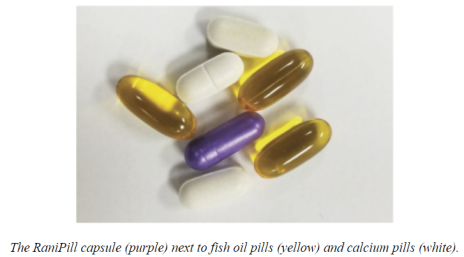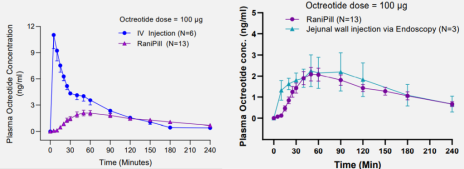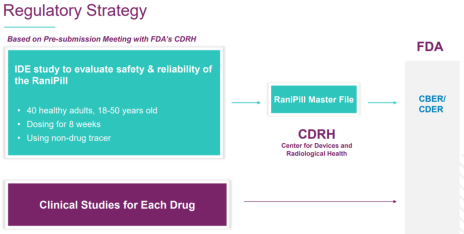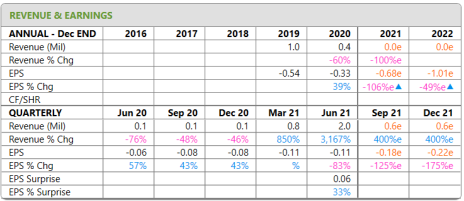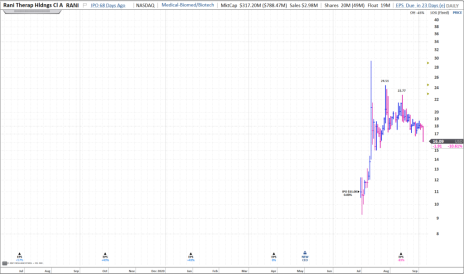Today we are jumping into a small-cap biotech company that has a drug delivery platform that could completely revolutionize how injectable drugs are delivered.
The short version is that millions of people that require injections could, if all goes well, just take a pill instead.
While the risks are meaningful with any biotech, so too is the potential. Early data shows this platform works, and already there are programs being designed to deliver treatments for osteoporosis, Type-2 diabetes and arthritis.
It’s all inside this month’s Issue.
Cabot Small Cap Confidential 269
[premium_html_toc post_id="238902"]
The Big Idea
If given a choice between taking a drug via pill or needle, how often would you choose the needle?
If you said never, congrats. You’re human.
Nobody in their right mind says, “I’ll just take the shot doc.” Unfortunately, there are still tons of medications that can only be delivered via subcutaneous or IV injection.
This isn’t for lack of effort.
Dozens of companies are working to reformulate drugs so they can be taken orally. But it’s not that easy. A shot gets the drug right into the bloodstream, whereas a pill goes to the stomach and digestive tract then needs to be absorbed from there. It’s far less direct.
Assuming a reformulated injectable drug is even safe to take orally, the major challenge then becomes delivering a sufficient dose into the bloodstream to produce the intended therapeutic effect. That’s called bioavailability. If sufficient bioavailability isn’t accomplished, it’s game over.
Thus far, most attempts to reformulate injectable drugs into orals have failed because the chemical agents that are added to improve absorption result in bioavailability of 1% or less. That’s not going to cut it when injectables often offer bioavailability in the 40% to 80% range.
That’s a shame. Because if a pill could work, the massive market for complex biologics – most of which require injections – would be completely turned on its head. Just to size the opportunity, industry analysts say the market for injectable drugs topped $400 billion in 2020 and is continuing to grow quickly.
People could take a pill for relatively common ailments such as osteoporosis, psoriatic arthritis and Type 2 diabetes. You could even get HGH pills to treat growth hormone deficiency.
These aren’t conditions that require an occasional shot. We’re talking frequent injections, sometimes multiple times a day. What a relief it would be for these people if they could avoid the needle.
The good news is there is potential.
While most companies are trying to change drugs to make them available in pill form, one player is developing a revolutionary type of pill and keeping the drug mostly the same.
Its novel approach is to put a tiny needle inside the pill. Once swallowed, that needle is pushed into the intestine to deliver the treatment.
It’s a remarkably elegant approach that’s shown promise in early-stage studies in both animals and healthy humans.
There’s a lot of work to be done to get this technology over the finish line. But the potential is huge. And it’s safe to say that very few investors are aware of it just yet.
Here’s the full story.
The Company
Rani Therapeutics (RANI) is a clinical-stage biotechnology company that is developing an orally administered pill – the RaniPill – to deliver biologics into the body. This pill is designed to give a precise therapeutic dose of treatments that are currently only available with injections.
Rani’s platform is different from many other oral pill formulations for injectable biologics because it doesn’t change the drug at all. Rani simply puts the injectable drug inside a capsule that is swallowed and which delivers an injection into the small intestine. All components of the RaniPill are biodegradable or easily passed through the GI tract.
This is a precise and tunable way to deliver a huge variety of drugs. And RaniPills can be taken over and over, just like the injections they could replace.
A pill alternative to needles is the holy grail of drug delivery. If it works this company, which currently has a market cap of $806 million, will likely be worth many multiples of what it’s worth now.
Rani could completely revolutionize the delivery of advanced therapies. It would be like taking an ibuprofen for something like osteoporosis or Type 2 diabetes.
Rani is very early-stage but is making good progress. It has several programs entering the clinic in 2022 and 2023, patented technologies, seasoned management, large and established development partners and compelling early proof-of-concept data.
That all said, success is far from guaranteed. At this stage of a typical biotech’s life cycle the standard assumed probability of success (POS) is roughly 15%. That applies here as well. As Rani works its way through various stages of development that probability will go up or down depending on results, and the stock will react accordingly.
What makes this investment worth the risk is that Rani’s platform approach is so different from many other companies’ attempts to solve this riddle, most of which require changing drug formulations.
Let’s dig in.
Platform & Products
With Rani’s oral delivery platform drug formulations are mostly the same as when delivered with a needle. But this is no ordinary pill capsule.
The RaniPill has a protective coating that resists the acids in the stomach. Once in the higher pH environment of the small intestine the coating dissolves, exposing a tiny, self-inflating balloon.
A pinch-valve in the balloon separates two compartments that hold reactants. Exposure to intestinal fluids dissolves this pinch-valve and the two reactants come together to produce carbon dioxide, which inflates the balloon.
The inflating balloon orients a tiny needle (smaller than a grain of rice) so that it is perpendicular to the intestinal wall. As the balloon inflates it pushes the needle into the intestinal wall where it rapidly dissolves, sending the drug it contains into the bloodstream.
Once the microneedle is delivered, the balloon deflates and passes through the body just like everything else in the intestine.
It’s a brilliant concept. And though it sounds a little like a modern take on Steven Spielberg’s 1987 movie Innerspace, Rani’s platform has shown success in early proof-of-concept studies in humans and canines. The most advanced study is RT-101 (discussed in minute).
Based on early results Rani is progressing with several studies in the U.S., including a repeat of the RT-101 Phase 1.
Here is an overview of the development pipeline, along with expected milestones.
Here are a few notes on each of the pre-clinical and Phase 1 programs.
RT-101 Phase 1
In the RT-101 Phase 1 study the RaniPill containing octreotide (Novartis) was given to 62 healthy men and women ages 18 to 55. Octreotide is approved for acromegaly (excessive growth hormone) which causes enlarged bones in face, feet and hands, as well as neuroendocrine tumors (NETs). Treatment requires three to four injections daily and is a barrier to some patients. Still, the global market is approaching $3 billion annually.
In RT-101 three versions of the RaniPill with incremental balloon sizes but the same dosage were administered. The primary endpoint of the study was safety and tolerability, with a secondary endpoint of bioavailability.
The study showed the capsule was well-tolerated by all subjects, there were no adverse events, and bioavailability was 65%. There was some variability in delivery success based on balloon size, and the most successful version delivered successfully in 80% of patients. Most failures were due to balloons not inflating, an issue Rani says has been fixed though manufacturing upgrades.
The chart below shows a comparison of the pill versus IV injection, as well as with endoscopic intrajejunal injection. As you can see IV injection delivers more quickly and at higher dosage, but the initial spike in dosage isn’t always necessary. The RaniPill bioavailability of 65% of IV injection is quite promising. The RaniPill delivered similar octreotide levels as compared to direct intrajejunal injection.
Rani is currently preparing a repeat dosing study for RT-101 in 2022 with a new and improved formulation to allow once daily dosing. A Phase 2 program should follow soon after.
RT-102
RT-102 will evaluate a RaniPill formulation of approved osteoporosis treatment Forteo (Eli Lilly), which went off patent around two years ago. Osteoporosis affects 30 million people in the US and EU and requires once-daily injections for months, if not years. This market is worth around $2 billion. Preclinical studies in canines and pigs show similar concentrations of Forteo delivered via RaniPill as compared to injection. Expect a Phase 1 study in healthy volunteers to start later in 2022.
RT-105
RT-105 has the potential to turn one of the biggest blockbuster drugs of all time, Humira, into an oral therapy. Humira is approved to treat certain types of arthritis and generates $20 billion in annual sales. However, AbbVie loses some patent protection for Humira in 2023 and FDA-approved injectable biosimilars are just waiting to pounce. If Rani can turn Humira into an oral therapy patients could avoid the cycle of two-week injections. The early data is compelling and Rani is laying the groundwork for a Phase 1 study in healthy volunteers in 2023. Note that prior to the planned start of this study we should know a lot more about how effective Rani’s delivery platform truly is.
RT-103/106
Nearly five million new patients in the U.S. and EU find that they have diabetes each year. Many manage with lifestyle changes, oral medications, careful blood sugar management and regular insulin injections. While there have been advances with pills (Novo Nordisk’s Rybelsus, and oral GLP-1 comes to mind) this is a big market and Rani’s attempts to develop an oral GLP-1 mimetic (RT-103) and oral basal insulin (RT-106) could make a big splash. As with other programs, early data is compelling and management has indicated a desire to work with large pharma companies to develop and bring these drug candidates to market.
Investment Highlights
Seasoned Management: Rani’s founder, Mir Imran, has previously started 13 companies, several of which were acquired by Boston Scientific (BSX), Eli Lilly (LLY), Medtronic (MDT) and others. Rani has received investments from Takeda (TAK), AstraZeneca (AZN), Novartis (NVS) and Google Ventures.
Platform Technology Establishing Proof of Concept: Extensive preclinical testing in animals (dogs and pigs) and healthy human volunteers has helped prove out the concept and offered insights into the safety and tolerability of the RaniPill.
Intellectual Property: The company has filed over 270 patent applications and more than 155 have been issued. Patent protection covers injecting into the GI tract, the mechanism and design of the RaniPill, nominated pipeline therapies and potential future applications. Not factoring in extensions, Rani’s current patents extend into 2030.
Partnership Potential: The RaniPill doesn’t mess with drug formulations, so this technology is a perfect fit for many partnerships with established treatments.
Offers Pathway for Large Biopharma Cos to Extend Off Patent Treatments: As patent protection for injectables falls off several large biopharma companies could see the RaniPill as a way to better monetize their treatments. This explains, in part, why companies including Takeda and Novartis are currently collaborating with Rani.
Potential to Streamline Regulatory Process: Rani is working on an initial drug-agnostic safety investigational device exemption (IDE) study, which has the potential to reduce the costs and timeline for each program since, if approved, it would only need to conduct clinical studies for each drug.
RaniPill Manufacturing: Rani has produced over 30,000 RaniPills to date and has capacity to support current programs. Longer term, Rani is developing a large-scale manufacturing platform designed to produce 50,000 capsules daily at a cost less than $1 per capsule.
The Business Model
Rani is a development-stage biotech company and as such is primarily designing and running trials. There is a medical device aspect to the story as well given the delivery platform, as well as a manufacturing aspect given aspirations to distribute RaniPills at scale.
The Bottom Line
Rani is not generating any revenue, nor will it for some time (maybe 2026-2027 timeframe). The company raised $84 million in its July 2021 IPO and ended Q2 with around $150 million in cash. Management says that should cover operational expenses through 2023. With around 50 million shares outstanding we see only modest share count increases in the coming quarters as the first secondary offering should be pushed out into 2023. A meaningful partnership/collaboration could represent an alternative to a secondary offering. With potential peak revenue of roughly $5 billion with the current pipeline the revenue opportunity here is significant.
Risk
Platform Technology Could Fail: The benefits of a single delivery mechanism for many drugs is also a potential downfall. If the RaniPill doesn’t work as designed, it will be back to the drawing board. That will mean delays and more capital and will likely destroy the stock.
Drug Reformulations Offer Another Option: Rani is not the only one trying to revolutionize the market. Other players are taking a different approach and reformulating injectables into oral pills. Potential competitor success with certain treatments could limit the market acceptance of the RaniPill, even if it is approved.
Young Company, Pipeline Just Building: The Phase 1 healthy volunteer study supports the RaniPill delivery concept, but we need more data on specific programs to generate greater confidence from investors and bring more money into this name. That will take time.
Second Half of 2022 Catalysts Require Patience: Rani won’t have any data in the next couple of months. As we get into the second half of 2022 we should get data on the repeat dosing of RT-101. Also, several other programs will enter the clinic later in 2022 and into 2023, meaning a catalyst-rich 2023.
Funding Requirements: Rani has roughly $150 million in the bank and will require much more before it gets products to market. With management saying it has the capital to get through 2023 we see a funding round in the 2023 – 2024 timeframe, absent an influx of capital through new partnership/collaboration or an outright acquisition.
Recent IPO: In addition to being a small-cap biotech, limited trading history (IPO July 30) will likely contribute to share price volatility for RANI.
Competition
There are many other companies out there trying to develop pills for therapies that are currently only available as injectables. While the formulations and mode of deliveries mean lots of variables in the market, the bottom line is that patients and doctors will gravitate toward what works and is priced within reason. Competitors to keep an eye on include Novo Nordisk (NVO), Applied Molecular Transport (AMTI), Oramed Pharmaceuticals (ORMP), Entera Bio (ENTX), Chiasma/Amryt Pharma (AMYT) and Protagonist Therapeutics (PTGX). Rani also faces competition from companies that make subcutaneous and IV injectable versions of its product candidates, including AbbVie (ABBV), Eli Lilly (LLY), Novartis (NVS) and Roche (RHHBY).
The Stock
Trading Volume: Average trading volume over the last three months is 360,000 but that’s skewed upward by higher volume in the two months following the IPO. Since late-September daily trading volume has typically been below 100,000 shares, and often below 50,000 shares. Suffice to say, our subscriber group can and likely will move this stock so keep that in mind today and over the coming days. Average in!
Historical Price: RANI came public at 11 on July 30. The stock was modestly strong in the first week of trading then surged to an intraday high of 29.4 on August 11. It closed at 20.74 (up 50% that day) then spent the next two weeks wobbling between 15 and 20. Since then we’ve seen the stock climb to just above 20 with a few spikes into the 22 to 25 range, then gradually retreat back into the mid to high teens after the Q2 report on September 13. Trading volume has receded lately and is likely to remain subdued until catalyst dates approach and/or larger investors try to snap up (or sell) shares.
Valuation & Projected Price Target: If we look at the market potential for each of Rani’s development programs and take a stab at a rough value for the platform (let’s say $2.5 billion) we could say the company could have a theoretical value of $5 billion to $7 billion if all programs were generating revenue right now. That would imply a per share value of around $100. However, nothing is approved right now and at this stage (pre-clinical to Phase 1) the standard biotech asset probability of success (POS) is near 15%. In other words RANI is probably worth somewhere between 15 and 30, depending largely on what POS you give the platform (probably higher than 15% given success to date). At this very early stage the stock will move dramatically upon trial results, meaning price targets are nothing short of meaningless. But if they matter to you, we’ll start at $25 and go from there.
Buy Range: Given the early stage of development and recent IPO status we are starting with a half position in RANI in the 15 to 20 range. I will advise on when to begin filling the second half.
The Next Event: Nothing on the immediate calendar. Q3 results expected later in October or early November. Pipeline catalysts (trial starts) to begin in second half 2022.
Updates on Current Recommendations
| Stock Name | Date Bought | Price Bought | Price on 10/6/21 | Profit | Rating |
| Accolade (ACCD) | 8/6/20 | 40 | 40 | 0% | Buy |
| Arena Pharmaceuticals (ARNA) | 2/2/18 | 39 | 59 | 52% | Buy |
| Avalara (AVLR) | 2/1/19 | 40 | 168 | 320% | Buy |
| Cerence (CRNC) | 10/1/20 | 50 | 85 | 71% | Hold |
| CS Disco (LAW) | 9/2/21 | 57 | 45 | -20% | Buy |
| Everbridge (EVBG) | 12/2/16 | 16 | 147 | 846% | Buy |
| Fiverr Intl (FVRR) | 3/5/20 | 32 | 178 | 450% | Buy |
| Inspire Medical (INSP) | 10/4/19 | 59 | 241 | 311% | Hold |
| JOANN (JOAN) | 8/6/21 | 15 | 10 | -32% | Buy |
| Kornit Digital (KRNT) | 3/4/21 | 102 | 144 | 41% | Buy |
| On24 (ONTF) | 7/1/21 | — | — | — | Sold |
| Q2 Holdings (QTWO) | 4/1/16 | — | — | — | Sold |
| Rani Therapeutics (RANI) | New | — | 16 | — | Buy |
| Repligen (RGEN) | 11/2/18 and 12/31/18 | 59 | 268 | 353% | Hold |
| Revolve Group, Inc. (RVLV) | 4/1/21 | 46 | 67 | 48% | Hold |
| Sprout Social (SPT) | 9/3/20 | 36 | 117 | 220% | Buy |
| Thunderbird Entertainment (THBRF, TBRD.V) | 5/6/21 | 3.8 | 3.8 | -2% | Buy |
Please email me at tyler@cabotwealth.com with any questions or comments about any of our stocks, or anything else on your mind.
Glossary
Buy means accumulate shares at or around the current price.
Hold means just that; hold what you have. Don’t buy, or sell, shares.
Sell means the original reasons for buying the stock no longer apply, and I recommend exiting the position.
Sell a Half means it’s time to take partial profits. Sell half (or whatever portion feels right to you) to lock in a gain, and hold on to the rest until another ratings change is issued.
Disclosure: Tyler Laundon owns shares in one or more of the stocks mentioned. He will only buy shares after he has shared his recommendation with Cabot Small-Cap Confidential members and will follow his rating guidelines.
The next Cabot Small-Cap Confidential issue is scheduled for November 4, 2021.
Cabot Wealth Network
Publishing independent investment advice since 1970.
President & CEO: Ed Coburn
Chief Investment Strategist: Timothy Lutts
Cabot Heritage Corporation, doing business as Cabot Wealth Network
176 North Street, PO Box 2049, Salem, MA 01970 USA
800-326-8826 | support@cabotwealth.com | CabotWealth.com
Copyright © 2021. All rights reserved. Copying or electronic transmission of this information without permission is a violation of copyright law. For the protection of our subscribers, copyright violations will result in immediate termination of all subscriptions without refund. Disclosures: Cabot Wealth Network exists to serve you, our readers. We derive 100% of our revenue, or close to it, from selling subscriptions to our publications. Neither Cabot Wealth Network nor our employees are compensated in any way by the companies whose stocks we recommend or providers of associated financial services. Employees of Cabot Wealth Network may own some of the stocks recommended by our advisory services. Disclaimer: Sources of information are believed to be reliable but they are not guaranteed to be complete or error-free. Recommendations, opinions or suggestions are given with the understanding that subscribers acting on information assume all risks involved. Buy/Sell Recommendations: are made in regular issues, updates, or alerts by email and on the private subscriber website.
Subscribers agree to adhere to all terms and conditions which can be found on CabotWealth.com and are subject to change. Violations will result in termination of all subscriptions without refund in addition to any civil and criminal penalties available under the law.

